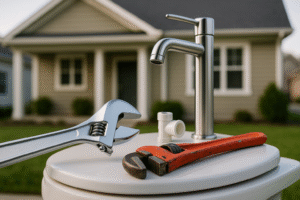Smart homes in 2025 look much different than old houses. IoT technology now runs these homes. Devices talk to each other and work as a team. They adjust lights, set temperatures, and watch over the house. Homeowners do not press many buttons or worry about small tasks.
These homes handle daily needs. They turn off lights when no one is around. They lower the heat when people leave. They also lock doors and send alerts if something seems wrong.
Homeowners enjoy more comfort. Rooms stay warm or cool without effort. Bills drop because smart systems cut waste. Owners also feel calm. They know their home keeps watch all the time.
Smart homes do not just save money. They protect families and help them live better each day.
How Do IoT Device Improve Daily Life?
Smarter Energy Use
Homeowners want to save money. They also want to protect the environment. Smart homes help them do both.
Smart thermostats learn daily patterns. They warm or cool rooms at the right times. People stay comfortable without high bills. Automated light switch off when no one is in the room. Homes stop wasting power on empty spaces.
Smart appliances also play a big role. Washers and fridges run smarter cycles. They use only the power they need. Smart ovens heat up fast and keep energy use low.
Smart meters show energy use right away. Owners spot problems on their bills. They fix habits and save more. These systems do more than cut costs. They also protect natural resources. Homes in 2025 waste less and care more for the planet.
Better Home Security
People worry about safety. Smart homes give them peace of mind.
Smart cameras show live video feeds. They watch doors, yards, and driveways. They also send instant alerts when someone moves outside. Owners see who comes close and act fast if needed.
Motion sensors spot odd activity around the house. They warn owners if someone walks where they should not. Smart locks give more control. Owner lock or unlock door from their phone. They do not need to carry keys or worry about losing them.
Facial recognition make home even safer. It knows family members and close friends. It warns owners if strangers stand near doors or windows.
These smart tools protect the home day and night. Owners check cameras anytime from anywhere. They travel without stress because their home always stays under watch.
Easier Kitchens
The kitchen is now a smart place. People save time and waste less food.
Smart fridge keep track of everything inside. They show lists on screens and warn when food gets low. They even suggest recipe based on what owner already have. This stop food from spoiling and keep meal fresh.
Smart ovens make cooking simple. Owner turn them on from their phone. The oven heat up before they walk in the door. Food come out right every time without long waits.
Dishwashers also work smarter. They test how dirty dishes are and use just enough water. Owner do not waste soap power or time.
Voice assistant stand by to help. They set timer read out recipe or play music. People keep hands on food instead of grabbing phones.
Cooking feels easier. Owner waste less and save more money each week. Smart kitchen turn daily tasks into quick stress free moment.
How Smart Homes Help Older Adults
Older people want to live at home. Smart homes make that easier.
Health monitors keep watch over heart rates and blood pressure. They spot problems early and send alerts to doctors or family. This stops small issues from turning serious.
Fall sensors give even more safety. They sense if someone falls and send out warnings right away. Family members or emergency teams get alerts in seconds.
Smart pill reminder help senior take medicine on time. They beep or flash lights so no dose gets missed. Voice assistants also make life simpler.
Families feel calm because they know someone is watching. Smart homes give them freedom and comfort for more years.
What Comes Next?
Smart homes already do a lot. They will soon do even more.
AI systems will watch daily habits and learn patterns. They will set lights, locks, and heat on their own. Owners will not need to lift a finger. Homes will feel even more personal.
New 5G networks will make smart devices faster. They will talk to each other without delays. This means smoother systems and quicker updates.
Green tech will also grow. Homes will find new ways to cut waste and use less power. They will protect the planet while saving money.
Homeowners will pay smaller bills. They will also live in safer spaces with less stress. Smart homes will become partners that handle life’s little tasks.
Final Thoughts
Smart homes change life in 2025. IoT devices cut costs, improve safety, and keep people happy. A home now does more than just give shelter. It thinks, learns, and protects.
Homeowners feel less stress each day. They trust their homes to handle small details. Light turn off on their own. Heat drop when no one is there. Doors lock without reminders. People worry less and enjoy more time with family.
Bills also shrink. Smart homes watch power use and stop waste. Owners save money month after month. They also know they help the planet by using fewer resources.
Safety is stronger too. Cameras watch doors and yards. Sensors warn when strangers come close. Homes stand guard day and night. Families travel or sleep without fear.
Smart home show a clear picture of the future. They promise a life that is simple safe and green. People live in comfort and feel calm. They stay in space that care for them and adjust to their need. This new way of living prove that technology does more than just entertain. It build a better easier life for everyone.
FAQ
What is a smart home in 2025?
A smart home in 2025 use IoT device that talk to each other. They set light adjust heat watch for danger and help save money.
Do smart homes really lower bills?
Yes. Smart thermostats light and appliance cut waste. Homeowner use less power and pay smaller bills each month.
Are smart home safe from hacker?
Most smart devices use strong security. Owners should pick trusted brands and keep systems updated. This stops most online risks.




